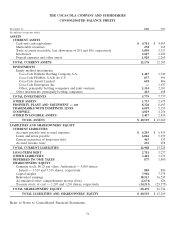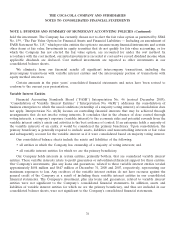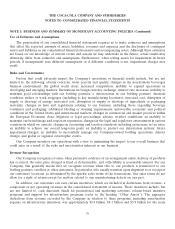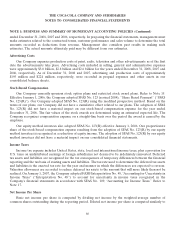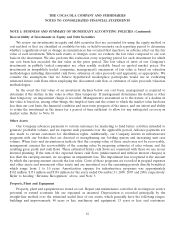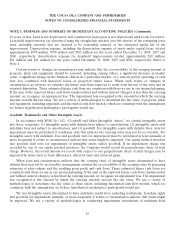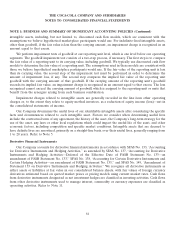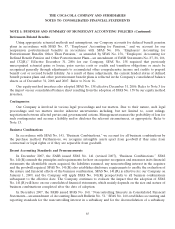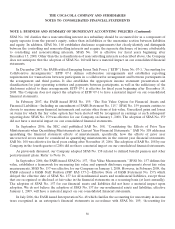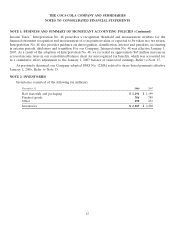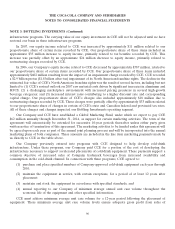Coca Cola 2008 Annual Report Download - page 84
Download and view the complete annual report
Please find page 84 of the 2008 Coca Cola annual report below. You can navigate through the pages in the report by either clicking on the pages listed below, or by using the keyword search tool below to find specific information within the annual report.THE COCA-COLA COMPANY AND SUBSIDIARIES
NOTES TO CONSOLIDATED FINANCIAL STATEMENTS
NOTE 1: BUSINESS AND SUMMARY OF SIGNIFICANT ACCOUNTING POLICIES (Continued)
Recoverability of Investments in Equity and Debt Securities
We review our investments in equity and debt securities that are accounted for using the equity method or
cost method or that are classified as available-for-sale or held-to-maturity each reporting period to determine
whether a significant event or change in circumstances has occurred that may have an adverse effect on the fair
value of each investment. When such events or changes occur, we evaluate the fair value compared to our cost
basis in the investment. We also perform this evaluation every reporting period for each investment for which
our cost basis has exceeded the fair value in the prior period. The fair values of most of our Company’s
investments in publicly traded companies are often readily available based on quoted market prices. For
investments in nonpublicly traded companies, management’s assessment of fair value is based on valuation
methodologies including discounted cash flows, estimates of sales proceeds and appraisals, as appropriate. We
consider the assumptions that we believe hypothetical marketplace participants would use in evaluating
estimated future cash flows when employing the discounted cash flow or estimates of sales proceeds valuation
methodologies.
In the event the fair value of an investment declines below our cost basis, management is required to
determine if the decline in fair value is other than temporary. If management determines the decline is other
than temporary, an impairment charge is recorded. Management’s assessment as to the nature of a decline in
fair value is based on, among other things, the length of time and the extent to which the market value has been
less than our cost basis, the financial condition and near-term prospects of the issuer, and our intent and ability
to retain the investment in the issuer for a period of time sufficient to allow for any anticipated recovery in
market value. Refer to Note 10.
Other Assets
Our Company advances payments to certain customers for marketing to fund future activities intended to
generate profitable volume, and we expense such payments over the applicable period. Advance payments are
also made to certain customers for distribution rights. Additionally, our Company invests in infrastructure
programs with our bottlers that are directed at strengthening our bottling system and increasing unit case
volume. When facts and circumstances indicate that the carrying value of these assets may not be recoverable,
management assesses the recoverability of the carrying value by preparing estimates of sales volume and the
resulting gross profit and cash flows. These estimated future cash flows are consistent with those we use in our
internal planning. If the sum of the expected future cash flows (undiscounted and without interest charges) is
less than the carrying amount, we recognize an impairment loss. The impairment loss recognized is the amount
by which the carrying amount exceeds the fair value. Costs of these programs are recorded in prepaid expenses
and other assets and noncurrent other assets and are amortized over the remaining periods directly benefited,
which range from 1 to 10 years. Amortization expense for infrastructure programs was approximately
$162 million, $151 million and $136 million for the years ended December 31, 2008, 2007 and 2006, respectively.
Refer to heading ‘‘Revenue Recognition’’ above, and Note 3.
Property, Plant and Equipment
Property, plant and equipment are stated at cost. Repair and maintenance costs that do not improve service
potential or extend economic life are expensed as incurred. Depreciation is recorded principally by the
straight-line method over the estimated useful lives of our assets, which generally have the following ranges:
buildings and improvements: 40 years or less; machinery and equipment: 15 years or less; and containers:
82




